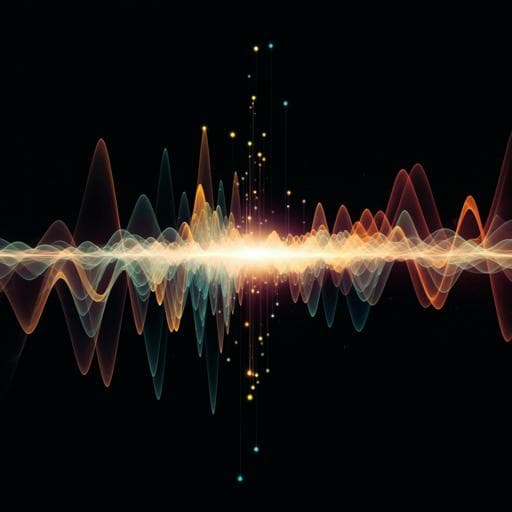
Engineering and Technology
Performing optical logic operations by a diffractive neural network
C. Qian, X. Lin, et al.
Discover the groundbreaking design strategy for optical logic operations using a diffractive neural network, demonstrated by Chao Qian and colleagues. Say goodbye to precise control of light properties and hello to a versatile solution that performs all seven basic optical logic operations, including NOT, OR, and AND gates, at microwave frequencies!
~3 min • Beginner • English
Introduction
The study addresses the challenge of realizing compact, stable optical logic operations without the need for precise control of input light parameters such as phase difference, polarization, intensity, and beam size. Conventional optical logic gate implementations, including plasmonic and interference-based approaches, depend on stringent control of these input properties, which hinders miniaturization and leads to instability and low intensity contrast between logic states in practical settings. The authors propose a universal design strategy leveraging a diffractive neural network implemented by a compound Huygens' metasurface to perform optical logic operations using simple plane-wave illumination. The input plane wave is spatially encoded at an input mask to represent the logic operator and input states, and hidden metasurface layers decode the encoded wavefront, directing energy to one of two small designated output regions representing logic '1' and '0'. The aim is to achieve all seven basic optical logic operations within a compact photonic system, overcoming prior limitations and enabling potential programmable, miniaturized optical processors.
Literature Review
Prior optical logic gates predominantly utilize constructive and destructive interference, through linear and nonlinear mechanisms, between multiple input light signals. These approaches require precise control over relative phase, polarization, intensity, and, in plasmonic nanowire configurations, strict constraints on beam size to avoid crosstalk or false inputs. Such stringent requirements complicate system design, necessitate bulky control apparatus, and lead to instability and reduced intensity contrast between logic states in practical scenarios. The literature includes linear interference-based gates and nonlinear (e.g., pump/control) optical logic gates, as well as plasmonic logic implementations, which collectively demonstrate feasibility but suffer from the aforementioned constraints that impede compactness and robustness.
Methodology
The authors design a diffractive neural network for binary optical logic classification comprising an input layer (optical mask), one or more hidden layers (metasurfaces), and an output layer with two small designated regions representing logic '1' and '0'. Input encoding: The input layer is partitioned into multiple regions, each associated with specific logic operators and input states. Each region has two transmittance states: high (selected, ~100% transmittance) and low (unselected, ~0% transmittance). By setting the transmittance state pattern, any of the seven basic optical logic operators and input combinations can be encoded onto the incident plane wave. Hidden layers: Each hidden layer is realized by a dense array of subwavelength meta-atoms forming a Huygens metasurface. Each meta-atom functions analogously to a neuron, coupling to subsequent layers via free-space diffraction. The forward model is based on Rayleigh–Sommerfeld diffraction. For a neuron at position r_i, the emitted Huygens wavelet is H_Huy(r−r_i)=G(r_i) h_Huy(r−r_i), with h_Huy(r−r_i)=−(1/(2π r))((ik/r)−(1/R)) e^{ik r}/R, where R=√((x−x_i)^2+(y−y_i)^2+(z−z_i)^2), k is the free-space wavenumber, and G(r_i)=u(r_i) t(r_i) is the product of the local incident field and complex transmission coefficient t(r_i)=a_l e^{j φ_l}. The total field at a subsequent plane is the superposition over all meta-atoms. Output decision: Two small output regions (radius < λ/2) are predefined; focusing most intensity into the left (right) region indicates logic '1' ('0'). Training: The complex transmission coefficients of meta-atoms in each hidden layer are trained using error backpropagation to minimize a mean squared error loss F(t)=Σ_k (s_{M+1}^k − g_{M+1}^k)^2, comparing output intensities at K measurement points to target distributions. The network is trained to achieve zero-error classification across all input cases without splitting into train/validation/test sets. Metasurface implementation (microwave demonstration): Frequency f0=17 GHz (λ0=17.6 mm). Two cascaded transmission metasurfaces separated by 17 λ0 are used for experiments; numerical demonstrations also include a three-layer case (spacing 22.7 λ). Each metasurface comprises 30×42 meta-atoms with square cross-section p=10 mm (~0.57 λ0), fabricated from F4B dielectric (ε_r≈3.5+0.003i) on a uniform slab of thickness a=3 mm. The transmission phase varies smoothly with meta-atom height h, approximately h≈λ0 φ/(2π Δn), enabling near phase-only modulation (|t|≈1). Experimental setup: A horn antenna (~45 λ away) provides a TE-polarized plane-wave-like illumination. A small monopole E-field probe scans the output plane to map amplitude and phase. Input masks are configured to encode specific logic operations (e.g., '1+0', NOT, OR, AND). Post-training, metasurfaces direct energy to the designated output region corresponding to the correct logic state.
Key Findings
- The diffractive neural network enables optical logic operations using plane-wave illumination without requiring precise control of input phase, polarization, intensity, or beam size.
- Numerical demonstrations show correct focusing of intensity into one of two designated output regions for NOT, OR, and AND operations across all input combinations.
- Experimental verification at 17 GHz with two metasurface layers confirms three logic operations (NOT, OR, AND). Measured intensity profiles show peaks confined within the correct designated region for each case, consistent with simulations.
- Quantitatively, the measured contrast ratios between intensities in the two designated regions exceed 9.6 dB for all tested cases.
- A numerical design with three metasurface layers demonstrates the ability to realize all seven basic optical logic operations with the same metasurface after training, using an input-layer encoding scheme and layer spacing of 22.7 λ.
- The approach assigns a consistent decision rule across all logic gates: left focus corresponds to logic '1' and right to '0'.
Discussion
The results demonstrate that a metasurface-based diffractive neural network can perform binary optical logic as a classification task, eliminating the need for stringent input-light controls that limit conventional interference-based and plasmonic logic gates. By encoding logic operations at the input mask and decoding through trained Huygens metasurfaces, the system robustly directs energy to designated output regions representing logic states, achieving high contrast and stability. The method is compact and compatible with plane-wave inputs, facilitating miniaturization and integration. Because the same hidden-layer metasurfaces can be trained to execute all seven basic logic functions—provided dynamic control at the input layer—the approach points toward a single programmable photonic processor for arbitrary logic. Experimental microwave implementations validate feasibility, and simulations suggest scalability to complete logic sets. Remaining discrepancies (weak fields outside target regions) are attributed to impedance mismatch and can be mitigated via antireflection structures. The strategy is general and, in principle, extendable to higher frequencies (terahertz and optical) with suitable metasurface platforms.
Conclusion
The paper introduces a universal, compact design strategy for optical logic using a diffractive neural network implemented by compound Huygens metasurfaces. With plane-wave inputs, logic operations are encoded at an input mask and decoded by trained metasurfaces that focus energy into designated output regions representing logic states. The authors experimentally demonstrate NOT, OR, and AND gates at 17 GHz with high contrast (>9.6 dB) and numerically show that all seven basic logic operations can be realized within the same framework. The approach removes the stringent input controls required by prior methods, enabling potential miniaturization and programmability. Future work could realize dynamically reconfigurable input layers (e.g., via spatial light modulators) for full in-situ programmability, extend implementations to terahertz and optical frequencies, improve impedance matching (e.g., antireflection structures) to further enhance contrast and efficiency, and explore cascading of multiple logic stages for complex optical computing architectures.
Limitations
- Experimental validation is limited to microwave frequencies; optical/terahertz implementations are proposed but not demonstrated.
- Residual stray fields at the output are observed, likely due to impedance mismatch at air–dielectric interfaces; this may reduce contrast and efficiency without additional antireflection engineering.
- Performance depends on fabrication accuracy and metasurface parameter fidelity; deviations can degrade trained responses.
- The system relies on plane-wave illumination and a predefined decision mapping; robustness to illumination deviations and environmental perturbations is not fully characterized.
- Dynamic reconfigurability of the input layer is discussed conceptually but not implemented in the experiments.
- Training is performed for zero-error on specified cases; generalization to untrained conditions or tolerance to model uncertainties is not assessed.
Related Publications
Explore these studies to deepen your understanding of the subject.







